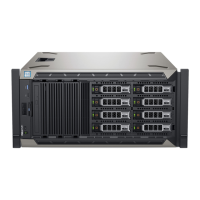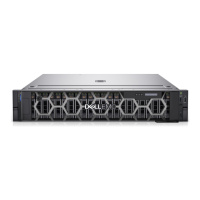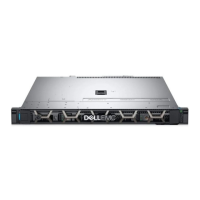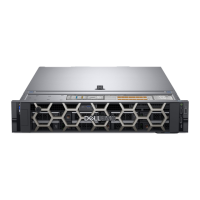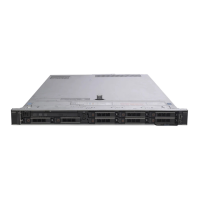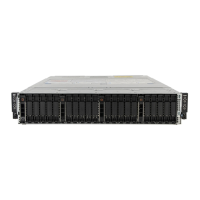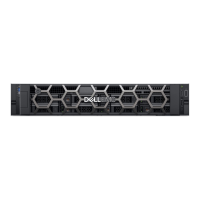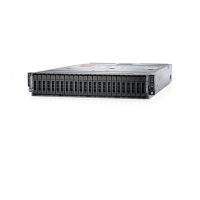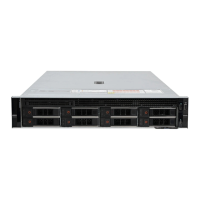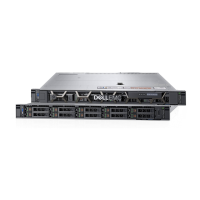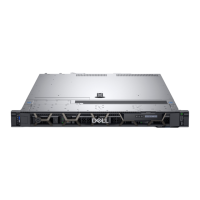Do you have a question about the Dell EMC PowerEdge T640 and is the answer not in the manual?
Details the various hardware configurations supported by the PowerEdge T640 server.
Identifies and describes the components and ports visible on the front of the server.
Explains the system health and system ID indicator codes for status monitoring.
Identifies and describes the components and ports visible on the back of the server.
Describes the link and activity status indicators for Network Interface Controllers.
Explains the indicator lights for AC and DC Power Supply Units (PSUs).
Provides instructions on how to find the system's unique Service Tag.
Details the physical dimensions of the T640 server chassis in millimeters and inches.
Lists the specifications for various AC and DC Power Supply Units (PSUs) supported.
Outlines the supported DIMM types, speeds, and configurations for system memory.
Lists the supported drive types and backplane configuration options for storage.
Describes the various ports and connectors available on the system, including USB and NICs.
Details temperature, humidity, and vibration limits for system operation and storage.
Provides a step-by-step guide for initial system setup and connecting peripherals.
Explains the role of iDRAC and options for configuring its IP address.
Outlines the various methods for downloading and installing system firmware and drivers.
Accessing and configuring System Setup, BIOS, Memory, Processor, SATA, Boot, and Network settings.
Explains the Dell Lifecycle Controller for embedded system management tasks.
Describes Boot Manager for boot options and PXE for network booting.
Outlines safety precautions and preparation steps for component replacement.
Procedures for installing/removing drives, carriers, adapters, and backplanes.
Procedures for managing power supply units, cooling fans, and air shrouds.
Procedures for installing/removing system memory modules and processors.
Procedures for installing/removing expansion cards, GPU holders, and IDSDM/vFlash modules.
Procedures for managing core system components like storage controller, battery, TPM, and system board.
Procedures for managing power interposer boards and control panel assembly.
Overview of the Embedded System Diagnostics (ePSA) for system hardware testing.
How to launch ePSA diagnostics via Boot Manager or Dell Lifecycle Controller.
Describes the controls available within the ePSA diagnostic interface.
Details the function and settings of system board jumpers for configuration.
Identifies and describes system board jumpers and connectors with a diagram.
Provides steps to disable system and setup passwords using a jumper.
Information on how to contact Dell support for assistance.
Guide on using the Quick Resource Locator (QRL) and QR codes for system information.
Details the various hardware configurations supported by the PowerEdge T640 server.
Identifies and describes the components and ports visible on the front of the server.
Explains the system health and system ID indicator codes for status monitoring.
Identifies and describes the components and ports visible on the back of the server.
Describes the link and activity status indicators for Network Interface Controllers.
Explains the indicator lights for AC and DC Power Supply Units (PSUs).
Provides instructions on how to find the system's unique Service Tag.
Details the physical dimensions of the T640 server chassis in millimeters and inches.
Lists the specifications for various AC and DC Power Supply Units (PSUs) supported.
Outlines the supported DIMM types, speeds, and configurations for system memory.
Lists the supported drive types and backplane configuration options for storage.
Describes the various ports and connectors available on the system, including USB and NICs.
Details temperature, humidity, and vibration limits for system operation and storage.
Provides a step-by-step guide for initial system setup and connecting peripherals.
Explains the role of iDRAC and options for configuring its IP address.
Outlines the various methods for downloading and installing system firmware and drivers.
Accessing and configuring System Setup, BIOS, Memory, Processor, SATA, Boot, and Network settings.
Explains the Dell Lifecycle Controller for embedded system management tasks.
Describes Boot Manager for boot options and PXE for network booting.
Outlines safety precautions and preparation steps for component replacement.
Procedures for installing/removing drives, carriers, adapters, and backplanes.
Procedures for managing power supply units, cooling fans, and air shrouds.
Procedures for installing/removing system memory modules and processors.
Procedures for installing/removing expansion cards, GPU holders, and IDSDM/vFlash modules.
Procedures for managing core system components like storage controller, battery, TPM, and system board.
Procedures for managing power interposer boards and control panel assembly.
Overview of the Embedded System Diagnostics (ePSA) for system hardware testing.
How to launch ePSA diagnostics via Boot Manager or Dell Lifecycle Controller.
Describes the controls available within the ePSA diagnostic interface.
Details the function and settings of system board jumpers for configuration.
Identifies and describes system board jumpers and connectors with a diagram.
Provides steps to disable system and setup passwords using a jumper.
Information on how to contact Dell support for assistance.
Guide on using the Quick Resource Locator (QRL) and QR codes for system information.
| power supply | 2400 W Platinum AC 100-240 V, 50/60 Hz, 16 A, 2000 W Platinum AC 100-240 V, 50/60 Hz, 11.5 A, 1600 W Platinum AC 100-240 V, 50/60 Hz, 10 A, 1100 W Platinum AC 100-240 V, 50/60 Hz, 12 A-6.5 A, 1100 W DC (-(48-60)) V, 32 A, 750 W Platinum AC 100-240 V, 50/60 Hz, 10 A-5 A, 750 W Titanium AC 200-240 V, 50/60 Hz, 5 A, 495 W Platinum AC 100-240 V, 50/60 Hz, 6.5 A-3 A |
|---|---|
| system battery | 3 V CR2032 lithium coin cell |
| maximum ambient temperature for continuous operation | 35°C/95°F |
